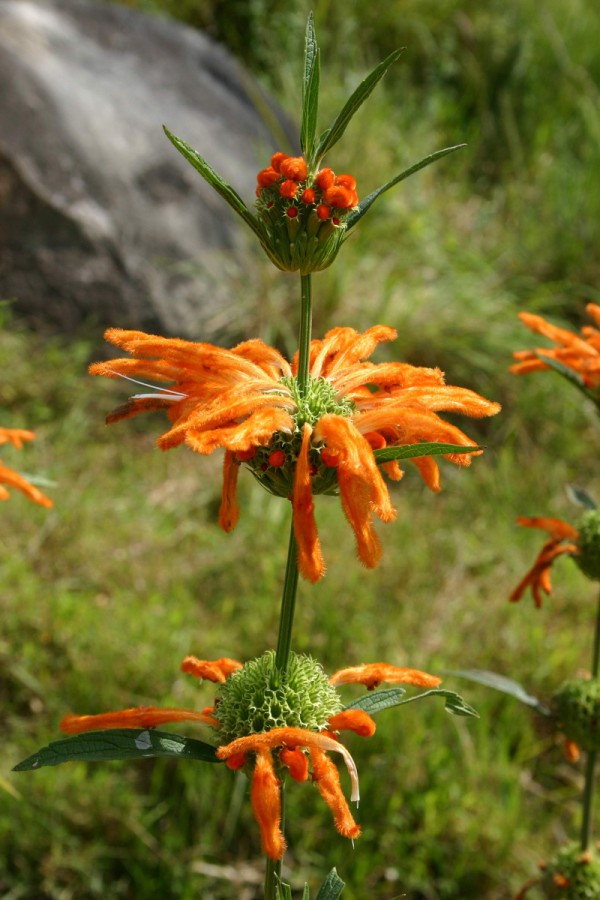Leonotis leonorus R.Br. - Lamiaceae - lion's ear, lion's tail, (wilde) dagga
Evergreen shrub, native to South Africa; flowers orange-red to scarlet. „Leonotis leonurus is cultivated as an ornamental plant for its copious orange blossom spikes and accent or screening qualities for use in gardens and parks… The name 'wild dagga' links it closely to cannabis as 'dagga' derived from the Khoikhoi 'dachab' is an indigenous South African name for cannabis species… The medium-dark green 2-4 inches (5.1-10.2 cm) long leaves are aromatic when crushed.“ http://en.wikipedia.org/wiki/Leonotis_leonurus
„Leaves yield a dark green residue smoked as a euphoriant by the Hottentots of Africa… Reported to be … a folk remedy for asthma… Toxicity and hallucinogenic properties seem rather insignificant.“
[CRC Handbook of Medicinal Herbs]
Major components of L.leonurus flower oil from Portugal were α-pinene, limonene, β-caryophyllene, α-humulene and caryophyllene oxide.
[Pedro, Luis G., et al. „Composition of the Essential Oil from Sepals of Leonotis leonurus R. Br.“ Journal of Essential Oil Research 3.6 (1991): 451-453]
„L. leonurus grows in moist areas, along hill-slopes and is commonly used for the treatment of liver inflammation.“
Main components of the essential oil of the leaves of L. leonurus growing in the Eastern Cape of South Africa were germacrene D (18.9%), limonene (15.6%), β-caryophyllene (15.2%), (Z)-β-ocimene (7.5%), γ-terpinene (4.7%), α-humulene (4.6%), terpinolene (3.6%), p-cymene (3.5%), (E)-β-ocimene (3.0%), and and bicyclogermacrene (3.0%).
Main components of flower oil were germacrene D (20.0%), β-caryophyllene (19.6%), (Z)-β-ocimene (10.8%), limonene (7.2%), α-humulene (6.5%), γ-terpinene (4.0%), and bicyclogermacrene (3.6%).
[Oyedeji, O. A., A. J. Afolayan, and J. N. Eloff. „Comparative study of the essential oil composition and antimicrobial activity of Leonotis leonurus and L. ocymifolia in the Eastern Cape, South Africa.“ South African Journal of Botany 71.1 (2005): 114-116]
„Marrubiin and an organic extract of Leonotis leonurus were tested in vitro and in vivo for their antidiabetic and anti-inflammatory activities… INS-1 cells were cultured under normo- and hyperglycemic conditions conditions. An in vivo animal model confirmed the biological activities of marrubiin and the organic extract observed in the studies in vitro… The stimulatory index of INS-1 cells cultured under hyperglycemic conditions was significantly increased in cells exposed to the organic extract and marrubiin, relative to the hyperglycaemic conditions. Insulin and glucose transporter-2 gene expressions were significantly increased by the organic extract and marrubiin. Similarly, the extract and marrubiin resulted in an increase in respiratory rate and mitochondrial membrane potential under hyperglycaemic conditions. Marrubiin increased insulin secretion, HDL-cholesterol, while it normalized total cholesterol, LDL-cholesterol, atherogenic index, IL-1β and IL-6 levels in an obese rat model.
The results provide evidence that marrubiin, a constituent of Leonotis leonurus, alleviates diabetic symptoms.“
[Marrubiin, a constituent of Leonotis leonurus, alleviates diabetic symptoms, N. Mnonopia, R.-A. Levendala, N. Mzilikazib, C.L. Frost, Phytomedicine, Vol.19(6), 2012, 488-493]
„Leonotis leonurus (L.) R. BR. Lamiaceae is extensively for the treatment of various ailments and in the Eastern Cape province of South Africa, it is used for the treatment of effects of gastrointestinal parasites in animals. There is, however, scanty information on the pharmacological activities of this plant. The aqueous extract from the leaf of L. leonurus was investigated for its analgesic and antiinflammatory properties… In the acetic acid-induced writhing model, the plant extract produced a significant (P < 0.05) reduction in the number of writhes with all test doses and at 100 and 200 mg/kg BWt, the extract produced results that were similar to those of Indomethacin. This study revealed the potential of L. leonurus leaf aqueous extract in reducing pain and inflammation, suggesting that it has some antiinflammatory and analgesic activities, hence, justifying its ethno-veterinary uses. The acute toxicity test showed that the plant is relatively safe to use.“
[Anti-inflammatory and analgesic activities of the aqueous extract of Leonotis leonurus leaves in rats. Maphosa, V., Adedapo, A. A., Moyo, B., Masika, P. J., African Journal of Biotechnology, Vol.11(26), 2014, 6878-6883]

Leonotis leonurus (L.) R.Br., Monk's Cowl area, Natal Drakensberg, South Africa, (PD, CC0)
https://commons.wikimedia.org/wiki/File:Leonotis_leonurus00.jpg